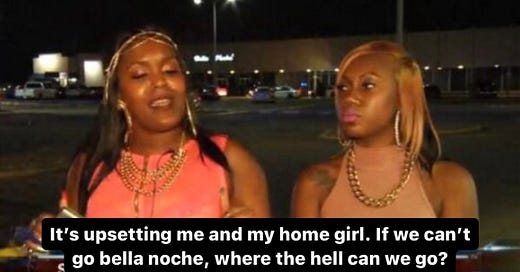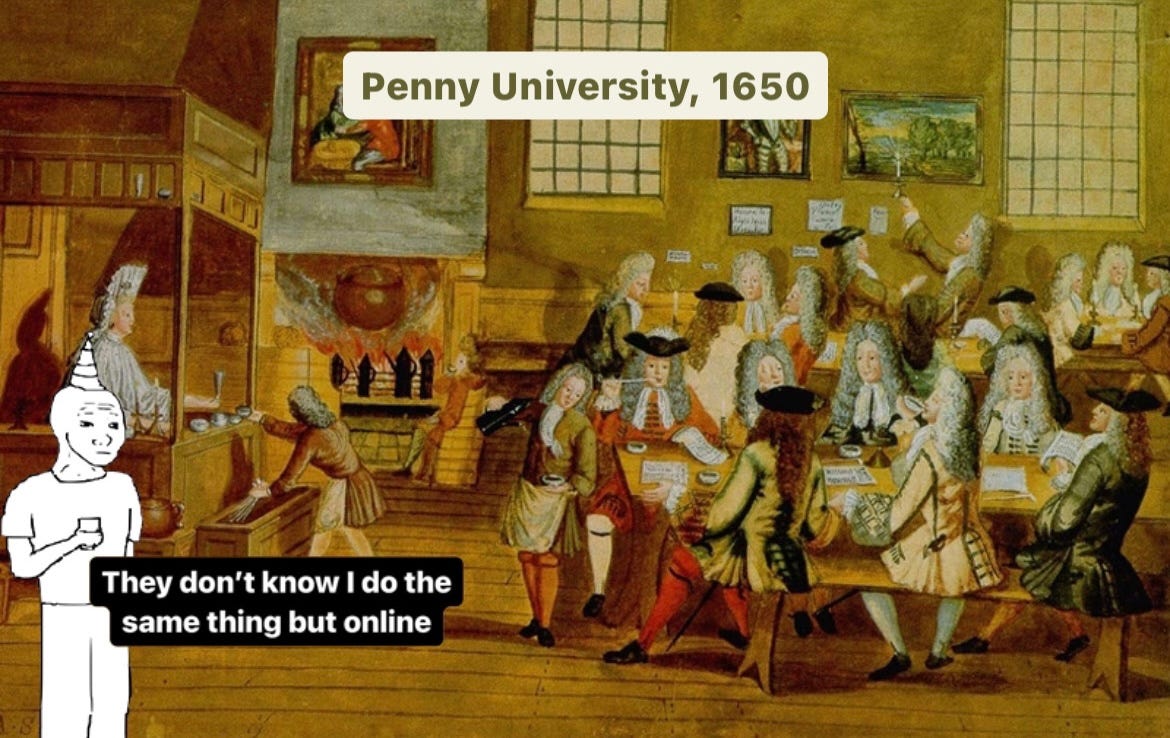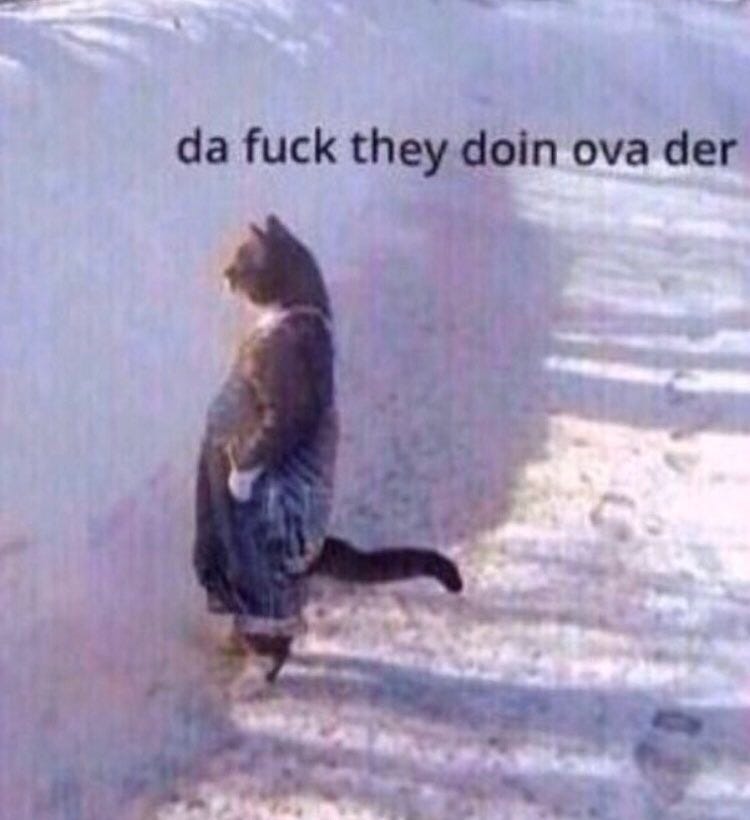Before we get into this edition, I want to start it off with this one question that’s been racking my brain for a while now…
Where do you go when coffee shops close at 4, you’re renting and the landlord has converted the living room into a bedroom (or maybe you live with family but it’s not really ~the vibe~), you can’t keep spending money to go see your friends (cozzie livs), your Prime Minister has put forward this new anti-social bill, and even if you did want to chill outside, you live in the U.K (i.e. do I dress for what the temperature is now or what it will be in a couple hours time)?
Welcome to our 39th edition where, I, Amaal (your friendly cultural commentator) explores ✨the death of third spaces✨
First things first, what are third spaces?
A third space is a public space that isn’t your home (first space) or where you work (second space), but where we congregate and socialise so cafes, libraries, bars, parks etc.
Womp womp womp, you can’t see your friends 😢🎻
Well actually 🤨, it serves more than that… let’s take it back to third spaces in 17th Century Oxford, England 🕰️
The first coffeehouses, established the year 1650 in Oxford, were known as penny universities. ‘Penny’ as admission would cost you a penny, and ‘university’ as the coffeehouses offered an alternative form of learning to university. It was a place where ‘like-minded scholars [would] congregate, to read, as well as learn from and to debate with each other’. (Also, something I just realised while writing this…is there where the saying ‘a penny for your thoughts' came from? 🤨)
In a society that put such great emphasis on class and economic status, the coffeehouses were unique; all you needed to enter? A penny. Although in saying this, women were rarely welcomed in taking part in the conversations, their presence were as proprietors of the establishment or coffee servers.
Some historians are of the opinion that coffeehouses had a social significance on the intellectual development of England. This isn’t all to say that we need more public social spaces to birth innovation and intellectual exchange, those things are great 👍🏾. What I am trying to highlight is the very human elements that we’re losing out on because of the decline of third spaces. These spaces serve as anchors of communities, a home/work divide, and improving and regulating our emotional and mental wellbeing.
Isn’t Tik Tok, Twitter and Reddit just online ‘coffeehouses’?
Over the past couple years, third spaces have been dwindling, which would of course lead to more people being online:
The reasons for the decline aren't as black and white as we think and can be attributed to several factors such as technology and increased interconnectedness, cuts to funding, polarisation, institutional distrust, and the cost of living to name a few.
Since the dawn of social media, and more so now post pandemic, people have flocked to the internet to share their ideas, opinions, and forge their own self-curated and affirming communities. We see this in the popular adoption of ‘core-culture’ and social media users content-ifying their life. We’re replicating, or even filling in, real life socialisation with its digital equivalent: online forums, social feeds and multiplayer gaming.
As highlighted in a previous edition, we're more interconnected than the generations before us because of the digital age we live in, however despite this, technology has actually led to a more isolated and disconnected society. In 2015, the BBC conducted a survey and found that the rate of loneliness in young people (18-24) was similar to that of the elderly.
POV: You’re chronically online and now it’s time to go outside
Dubbed the sustainability generation, Gen Z are leading the conversations (and also walking the talk) on being eco-conscious. But when it comes to logging off and going outside, they're stumped.
According to a study undertaken by Birda, a birdwatching community aimed at curious people who want to deepen their connection with nature, ‘almost half of 18 to 24-year-olds want to spend more time outdoors but are unable to find hobbies or activities to entice them outside.’
A government report by Natural England’s ‘People and Nature Survey (children)’, found clear inequalities in the number of children engaging with nature. 71% of children from ethnic minority backgrounds are spending less time outside since coronavirus compared with 57% of white children.
In addition, almost three-quarters (73%) of children from households with a total annual income below £17,000 spent less time outdoors, compared with 57% from households with an annual income above £17,000.
Has this changed online behaviour?
When researching this topic, I was curious to know if this shift in behaviour (a higher interest in IRL connectedness and socialisation) correlates to a shift in online behaviour. According to the comprehensive report by Datareportal, the amount of time spent online worldwide has declined by 5% year by year.
Some key findings from the report:
Working-age internet users spent an average of almost 7 hours per day online, but that’s fallen to 6 hours and 37 minutes per day
Younger women report the biggest drop in daily time spent using the internet.
Over the past 12 months, female internet users (16 to 24) have reduced their daily average internet time by 50 minutes. Estimated to reduce their annual online time by a total of 12½ days in 2023 compared with the previous year
As the report highlights, the data does not suggest that people will find the internet becoming less important to them but rather, users are becoming more purposeful and intentional with how they consume and engage online; quality over quantity.
“Though notable drops in time spent online illustrate a decrease in pace – reflecting the post-pandemic landscape and how people now have less time to spare – a combination of media fatigue, subscription churn, and the cost-of-living crisis play an equally important role in flattening the curve.” - GWI’s, “Global Media Landscape” report
So what are we getting at here? Well, all of this points to the great need for more connected communities and diverse, inclusive cost-free public spaces whatever your background. We need more purposeful modular spaces like Bone Soda’s ‘DIJONSS’ where you can join a chess club or attend a music production workshop. We need more inclusive (of background and ability) sports clubs like ASRA, a run club & community space centering Muslim women in sports, wellness & sisterhood.
The demand and interest is there, we just need to facilitate it.
This wouldn’t be a Fax No Printer edition if we didn’t add in our critical thinking questions! Let’s carry on this conversation as we’re not here to give the answers but to facilitate thought and conversations. So here goes:














